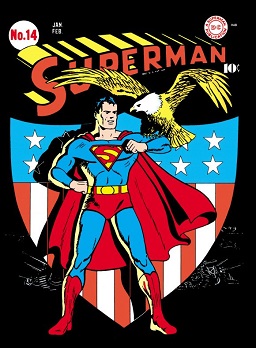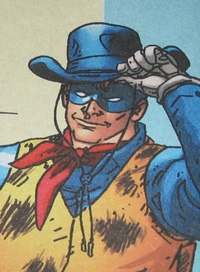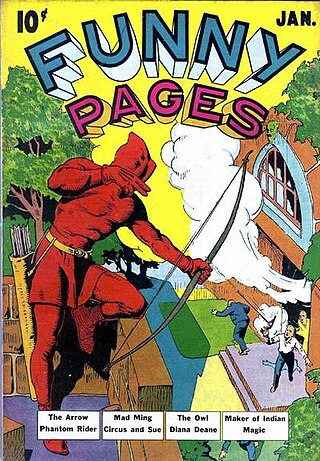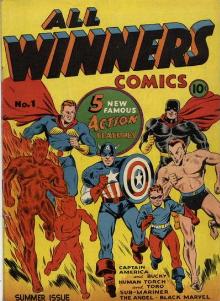
The Golden Age of Comic Books describes an era of American comic books from 1938 to 1956. During this time, modern comic books were first published and rapidly increased in popularity. The superhero archetype was created and many well-known characters were introduced, including Superman, Batman, Robin, Captain Marvel, Captain America, and Wonder Woman.

Timely Comics is the common name for the group of corporations that was the earliest comic book arm of American publisher Martin Goodman, and the entity that would evolve by the 1960s to become Marvel Comics.
The Scourge of the Underworld is the name of a series of fictional characters appearing in American comic books published by Marvel Comics.

Marvel Mystery Comics is an American comic book series published during the 1930s–1940s period known to fans and historians as the Golden Age of Comic Books. It was the first publication of Marvel Comics' predecessor, Timely Comics, a division of Timely Publications.

Miss America is a superhero appearing in American comic books published by Marvel Comics. Created by writer Otto Binder and artist Al Gabriele, the character first appeared in Marvel Mystery Comics #49 in the Golden Age of Comic Books. Madeline Joyce is the first incarnation of Miss America. The character has also been a member of the Invaders and Liberty Legion at various points in her history.

The Two-Gun Kid is the name of two Western fictional characters appearing in American comic books published by Marvel Comics. The first, Clay Harder, was introduced in a 1948 comic from Marvel predecessor Timely Comics. The second, Matt Hawk a.k.a. Matthew J. Hawkins, was introduced in 1962 and has continued into the 2010s. The latter Kid is better known, thanks primarily to his connection with, and later full integration into, Marvel Comics' shared continuity, known as the Marvel Universe, but the Clay Harder Kid enjoyed a 14-year span in comics.

All Select Comics is a 1943–1945 American comic book series published by Timely Comics, the 1940s predecessor of Marvel Comics, during the period fans and historians call the Golden Age of comic books. An omnibus series with several different superhero and other features each issue, it primarily starred Captain America and the original Human Torch, two of Timely's most popular characters, as well as fellow Timely star the Sub-Mariner in several.

The All-Winners Squad is a fictional superhero team appearing in American comic books published by Marvel Comics. The company's first such team, it first appeared in All Winners Comics #19, published by Marvel predecessor Timely Comics during the period fans and historians call the Golden Age of Comic Books.

Jeffrey Solomon Mace, also known as the Patriot and Captain America, is a superhero appearing in American comic books published by Marvel Comics. The character was created during the 1940s, a period fans and historians call the Golden Age of Comic Books. As the Patriot, he first appeared in Human Torch Comics #4, published by Marvel's 1940s precursor, Timely Comics.

The Blazing Skull is a fictional character appearing in American comic books published by Marvel Comics. The character was created during the Golden Age of Comic Books by Marvel's predecessor, Timely Comics, and first appeared in Mystic Comics #5. The character's writer and artist creators are unknown. The Blazing Skull fell into obscurity after the 1940s, and was revived in the 1990s.

The Blonde Phantom is a fictional masked crime fighter appearing in American comic books published by Marvel Comics. Created for Marvel predecessor Timely Comics by Stan Lee and Syd Shores, the character first appeared in All Select Comics #11, during the 1940s period fans and historians call the Golden Age of Comic Books. The heroine was so well received that the next issue was retitled The Blonde Phantom. The series continued to feature her until issue #22. She also appeared in backup stories in many other Timely comics; in Superhero Comics of the Golden Age, Mike Benton observes that "for a few months in 1948, readers could find her in seven titles on the newsstand." In The Supergirls, Mike Madrid asserted, "Once again, a capable woman hid behind a meek persona and only let her hair down, literally, to come to the aid of a man who completely ignored her unless she assumed a disguise. In a 1947 story entitled "I Hate Myself", Louise even dreams that Mark finally confesses his love for her, only to have the Blonde Phantom persona appear and steal him away."

Betsy Ross is a character appearing in American comic books published by Marvel Comics. Created by Joe Simon and Jack Kirby, the character first appeared in Captain America Comics #1. Betsy Ross is Captain America's early love interest and supporting character in American comic books published by Marvel Comics during the 1930-1940s period known to historians and collectors as the Golden Age of Comic Books. She then debuted as the superheroine Golden Girl in Captain America Comics #66.

The Arrow is a fictional superhero created during the Golden Age of Comic Books. He was the first superhero published by Centaur Publications.

All Winners Comics was the name of two American comic book series of the 1940s, both published by Marvel Comics' predecessor, Timely Comics, during the period fans and historians call the Golden Age of Comic Books. A superhero anthology comic in both cases, they variously featured such star characters as Captain America, the original Human Torch, and the Sub-Mariner. All Winners Comics was also the venue for two full-length stories of Marvel's first superhero team, the (hyphenated) All-Winners Squad.

Jester is a fictional character, a Golden Age superhero created by Paul Gustavson and published by Quality Comics. He first appeared in Smash Comics #22. Like most of Quality's characters, the Jester was later purchased by DC Comics and incorporated into their universe. Though little used by the company, he appeared in All-Star Squadron #31 and #60 and Starman #46. The character's last Golden Age appearance was in Smash Comics #85.
Al Gabriele was an American comic book artist during the 1940s period fans and historians call the Golden Age of comic books. He was known for his work on some of Marvel Comics' earliest Captain America and Sub-Mariner stories, and for co-creating the company's superheroes Black Marvel, Miss America, and possibly, the Whizzer.
Mystic Comics is the name of three comic book series published by the company that eventually became Marvel Comics. The first two series were superhero anthologies published by Marvel's 1930-1940s predecessor, Timely Comics, during what fans and historians call the Golden Age of comic books. The third, simply titled Mystic, was a horror fiction-suspense anthology from Marvel's 1950s forerunner, Atlas Comics.
Harry Frank Sahle was an American comic book artist who drew for such publishers as Archie Comics—helping create the defined look of Archie Comics' breakout character, Archie Andrews—Quality Comics and the Marvel Comics precursor company Timely Comics during the 1930s-1940s period historians and fans call the Golden Age of Comic Books.

The Destroyer is the name of three fictional superheroes appearing in American comic books published by Marvel Comics. The original incarnation was created by writer Stan Lee and artist Jack Binder, and first appeared in Mystic Comics #6, being one of Lee's earliest creations during the Golden Age of comic books.

George Kapitan was an American writer for Timely Comics, the 1940s predecessor of Marvel Comics, during the time fans and historians call the Golden Age of Comics. He co-created the medium's first costumed, superpowered female protagonist, the Golden Age Black Widow, an antiheroine who killed evildoers to deliver their souls to Satan, her master.















